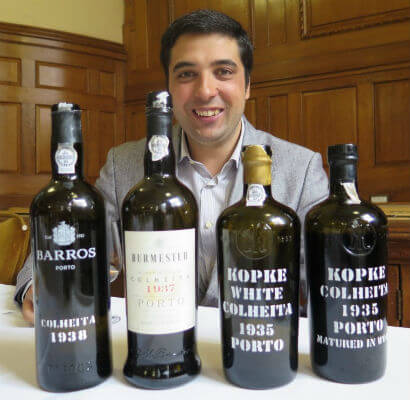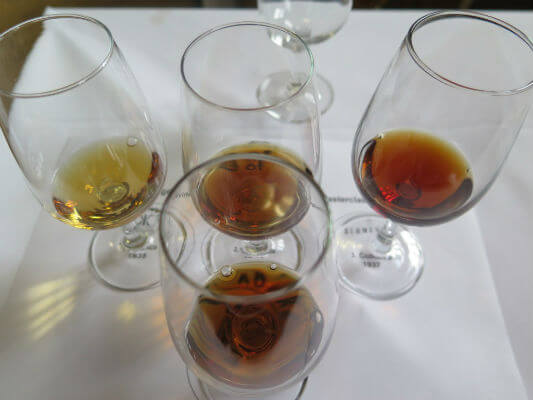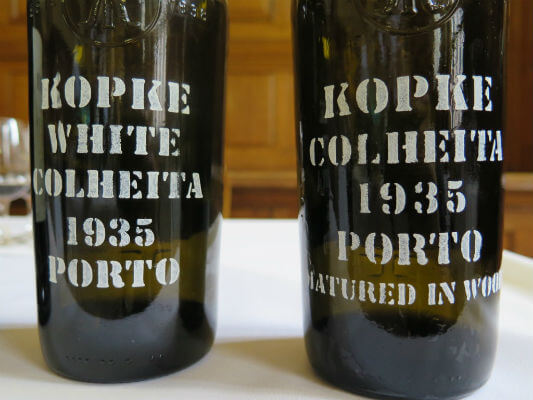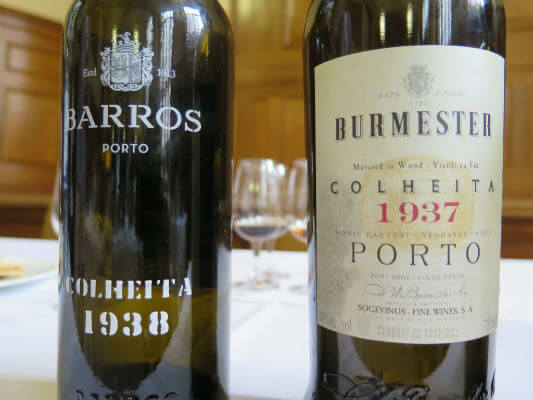Text Sarah Ahmed
The Big Fortified Tasting is the largest wine fair in the world exclusively dedicated to fortified wines. It’s also one of my favourite tastings of the year, not least because wood-aged fortifieds – vinous works of time – are amongst the most delicious, complex wines on earth. So I jumped at the chance to attend the “House of Tawnies” Masterclass in which Sogevinus turned back the clock to the 1930s. It may have been the depression era but, from a Port perspective, there was much to celebrate as we tasted Colheita (single vintage Tawny) Ports from 1935, 1937 and 1938!

Sogevinus Chief Winemaker Carlos Alves – Photo by Sarah Ahmed | All Rights Reserved
Leaving aside the evident quality of these Ports, the self-styled “House of Tawnies” moniker is no idle boast. When Sogevinus acquired Kopke, Burmester, Barros and Cálem a decade ago, it took possession of Portugal’s largest stock of Colheitas (single vintage tawnies) – the group has 17 million litres of Tawny Port according to Chief Winemaker Carlos Alves. What’s more, since Colheitas are bottled to order, they remain in wood for very much longer than the legal minimum of seven years. It was quite remarkable to think that we were tasting wines which had spent up to 80 years in wood! All four Colheitas had only been bottled a fortnight beforehand.

The Four Glasses on the Tasting Mat – Photo by Sarah Ahmed | All Rights Reserved
It’s a longevity which relies on both a mastery of grape sourcing and the caretaking of these fine rare Ports during their long spell in wood. Alves explains, not only must the grapes have the structure to age, they must also fit with the house style. He assesses this in the vineyards each year at harvest; grapes for the Colheitas are the first to be allocated where this category is so emblematic for the company.
For Kopke, Colheitas have been sourced from the middle and upper slopes of Quinta S. Luiz near Pinhão in the Cima Corgo since the 1920s. Rising to 600m, it provides the acidity for Kopke’s very structured, intense style. When Barros acquired Kopke in 1952, it also looked to Quinta S. Luiz for grapes but, this time, grapes with a higher sugar content are selected from two lower, hotter parcels within the vineyard near the river. They are better suited to this house’s richer Ports.
As for looking after the Ports during their time in wood, Alves has a dedicated team of two because “they need to know the wines to work them well.” He adds, they are very careful to ensure that the pipas, toneis and casks remain linked to the same house “because the wood – size and type of wood – really gives profile to the house.” For example with the greatest variety of casks, Cálem has a tradition of ageing in exotic hard wood.
At least once a year, Alves and his team transfer Colheitas from their individual 550 litre pipa (Port barrel) to a large cask in order to adjust the spirit (a neutral brandy spirit which evaporates over time) and maintain the requisite level of alcohol (the spirit integrates much better when done on a larger scale in cask). Airing the Ports in this way together with cleaning the pipas before the Ports are returned to them also explains why the 30s’ Colheitas – the oldest wines which the company has for sale – retained such admirable freshness. Here are my tasting notes:
Kopke Porto Branco 1935
Established in 1638 by Christiano Kopke and his son Nicolau, Kopke is the oldest Port wine export firm. In 1953, it was acquired by the Barros family in whose family it remained until 2006 when it was acquired by Sogevinus. With around 45g/l residual sugar, this rare pale amber example of a Colheita made from white grapes is drier in style than Kopke’s Tawny Colheita made from red grapes. It has a firmer, more focused yet restrained nose and palate with a distinctive ozone/sea spray note and a fino-like nuttiness – lighter and less sweet than the nuttiness which I associate with tawnies. And perhaps because it has less extract and residual sugar, its freshness is particularly marked. From a highly regarded Douro vintage it has a striking intensity of perfumed orange peel, orange and apple eau-de-vie and hints of spicy aniseed to the long, clean finish.

Kopke Porto Branco 1935 & Kopke Porto Colheita 1935 – Photo by Sarah Ahmed | All Rights Reserved
Kopke Porto Colheita 1935
Deep amber with a saffron rim. With its orange and grapefruit peel notes to the nose, it has a palpable sense of freshness – an edginess. But there’s a richness too, which puts me in mind of yolky Madeleine biscuits. In the mouth it has terrific energy. A nutty spine brings length and tension, grapefruit and orange peel lift add spice, while a touch of “vinagrinho”/ fruit chutney makes for a tangy counterpoint to its sweet and mellow dried fig. A long, very resonating finish has lovely timbre. Fabulously complex and characterful.
Burmester Porto Colheita 1937
Henry Burmester and John Nash began shipping Port wine to the British Isles following their arrival in Vila Nova de Gaia in 1750. The Port house remained in the Burmester family until 2005 when it was acquired by Sogevinus. Though dark toffee coloured in hue, this is an exceptionally silky Colheita, very different in mouthfeel (and apparent sweetness) from the Kopke. It seems much younger, so seamless and harmoniously fruity is its salt caramel edged palate. Alves describes it as “a box of perfume” because of its aromatics. It delivers tamarind, sweet cinnamon and black cardamom spice to its dried and tangier apricot chutney fruit. Rich but beautifully balanced, it has great poise and persistence to the café crème tobacco accented finish. Mellifluous, very elegant.

Barros Porto Colheita 1938 & Burmester Porto Colheita 1937 – Photo by Sarah Ahmed | All Rights Reserved
Barros Porto Colheita 1938
Barros was established in 1913 by Manoel de Almeida and acquired by Sogenvinus in 2006. From a hot year, the Barros is a deep tawny hue with saffron and olive to the rim. It’s a little spirity on the nose with a hint of walnut which, though the converse is true, would suggest it is the older of the Tawny Colheitas. In the mouth, it is more toothsomely sweet with medjool dates, crème caramel, salt caramel and nougat to the mid-palate. However, the finish shows a trace of dustiness and bitter walnut – it’s drying out a little. It’s not as harmonious as the others.
My favourite? I find it hard to choose between the Kopke and the Burmester – they’re such different styles, as it should be. On balance, the Kopke is the more ethereal of the two – I loved its energy, tension and lift. But the Burmester’s silky balance won most votes on the day.
Should you wish to do your own Burmester v Kopke challenge, why not join me on Blend All About Wine’s trip to Oporto, Vinho Verde and the Douro next month? We’ll be pitting Kopke’s and Burmester’s 20 Year Old Tawny and White Ports against each other before finishing up with two Colheitas from Kopke from 1966 and, a favourite, the 1957 – one of my top Port picks in my December article for wine-searcher. Happy days!
Contacts
Sogevinus Fine Wines, S.A.
Avenida Diogo Leite nº 344
4400-111 Vila Nova de Gaia
Tel: +351 22 3746660
Fax: +351 22 3746699
E-mail: comercial@sogevinus.com
Website: www.sogevinus.com




Leave a Reply